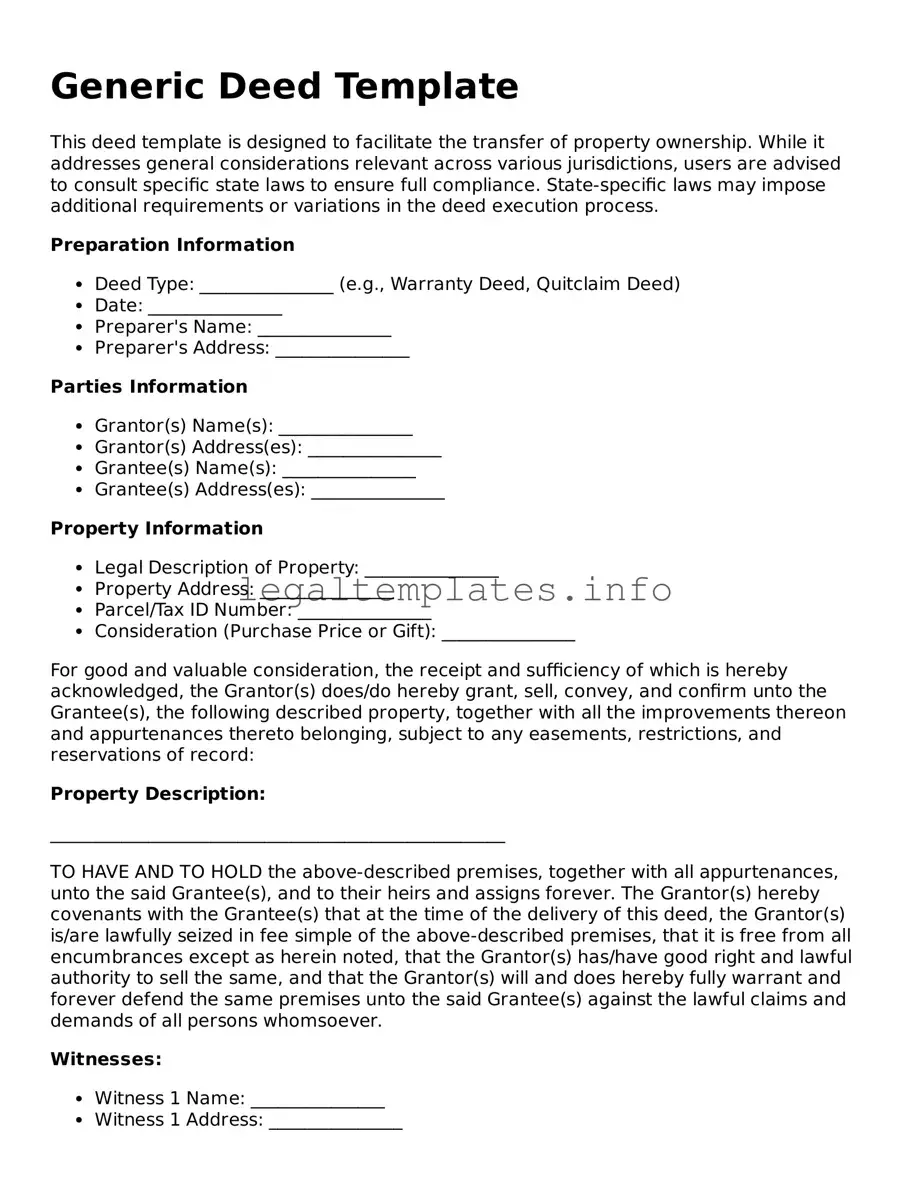Generic Deed Template
This deed template is designed to facilitate the transfer of property ownership. While it addresses general considerations relevant across various jurisdictions, users are advised to consult specific state laws to ensure full compliance. State-specific laws may impose additional requirements or variations in the deed execution process.
Preparation Information
- Deed Type: _______________ (e.g., Warranty Deed, Quitclaim Deed)
- Date: _______________
- Preparer's Name: _______________
- Preparer's Address: _______________
Parties Information
- Grantor(s) Name(s): _______________
- Grantor(s) Address(es): _______________
- Grantee(s) Name(s): _______________
- Grantee(s) Address(es): _______________
Property Information
- Legal Description of Property: _______________
- Property Address: _______________
- Parcel/Tax ID Number: _______________
- Consideration (Purchase Price or Gift): _______________
For good and valuable consideration, the receipt and sufficiency of which is hereby acknowledged, the Grantor(s) does/do hereby grant, sell, convey, and confirm unto the Grantee(s), the following described property, together with all the improvements thereon and appurtenances thereto belonging, subject to any easements, restrictions, and reservations of record:
Property Description:
___________________________________________________
TO HAVE AND TO HOLD the above-described premises, together with all appurtenances, unto the said Grantee(s), and to their heirs and assigns forever. The Grantor(s) hereby covenants with the Grantee(s) that at the time of the delivery of this deed, the Grantor(s) is/are lawfully seized in fee simple of the above-described premises, that it is free from all encumbrances except as herein noted, that the Grantor(s) has/have good right and lawful authority to sell the same, and that the Grantor(s) will and does hereby fully warrant and forever defend the same premises unto the said Grantee(s) against the lawful claims and demands of all persons whomsoever.
Witnesses:
- Witness 1 Name: _______________
- Witness 1 Address: _______________
- Witness 2 Name: _______________
- Witness 2 Address: _______________
IN WITNESS WHEREOF, the Grantor(s) has/have hereunto set their hand(s) and seal(s) this the ____ day of __________, 20__.
____________________________________
Grantor's Signature
____________________________________
Grantor's Printed Name
____________________________________
Grantee's Signature
____________________________________
Grantee's Printed Name
State of _______________
County of _______________
On this ____ day of __________, 20__, before me, _____________________ (name of notary), a notary public, personally appeared _______________, known to me (or satisfactorily proved) to be the person(s) whose name(s) is/are subscribed to the within instrument, and acknowledged that he/she/they executed the same for the purposes therein contained.
In witness whereof, I hereunto set my hand and official seal.
____________________________________
Notary Public Signature
____________________________________
Notary Public Printed Name
My commission expires: _______________
